There are artists of whom, thanks to historical biographies and documentary evidence, we know with certainty theentire existence, including their movements, their frequentations, their commissions, and sometimes even their thoughts, even if these lived centuries and centuries ago, and there are, on the other hand, artists of whom we still know very little nowadays, and for this reason the work of scholars to try to reconstruct as faithfully as possible the lives of these is still ongoing, through studies, updates and comparisons. Such is the case with Cecco del Caravaggio (Francesco Boneri; c. 1585-after 1620), a painter active between the sixteenth and seventeenth centuries who was a pupil and model of Caravaggio; we can assume his date of birth to be around 1585. He is “the only artist of the so-called Caravaggio circle whose certain place and date of birth are still unknown, just as we do not know his place and date of death,” points out Gianni Papi, the scholar to whom we owe the reconstruction of the artist as we now know it. And it is precisely on this reconstruction that the exhibition Cecco del Caravaggio. The Model Pupil set up until June 4, 2023 in the renovated spaces of theCarrara Academy in Bergamo and curated by Papi himself and Maria Cristina Rodeschini, director of the museum venue.
“The exhibition is thus the outcome of that reconstruction and of it presents all the aspects and reasons of interest, as well as the uncertainties,” writes the curator in the catalog, who has devoted 30 years to research on Cecco, resulting in several publications, including two monographs in 1992 and 2001 and a series of articles and contributions. “Such reconstruction is-never as in this case- circumstantial, often suggestive, built on elements that support each other with a shareable logic, yet without any of them being definitively established,” Papi explains. “Cecco proposes an ongoing challenge, because of his stubborn decision to hide himself, to provide no traces of himself, to entrust to a group of paintings - most of them mysterious, sometimes shocking - everything he wants to make known about himself.” Papi has speculated in the past about a sort of damnatio memoriae, but he also realizes that the artist in question may be “a completely atypical character, probably intolerant of rules, destined to arouse contrasts, perhaps enmities.” His name does not appear in either historical or judicial chronicles or even in Easter censuses. Mentioned in Easter 1605 is a “Francesco garzone” surveyed along with Caravaggio in his home in vicolo San Biagio, likely identifiable with Cecco del Caravaggio (document first published in 1981 by Marini). His first and last name, Francesco Boneri, emerges only twice: on January 6, 1619, in the lists of the Accademia di San Luca, as an affiliate in a congregation, he appears as “Francesco Boneri” in the company of Giovanni Baglione and others such as Ottavio Leoni, Tommaso Salini, Paolo Guidotti, Baccio Ciarpi and Alessandro Turchi. An interesting novelty that emerged thanks to Francesca Curti ’s research in the Capital’s archives on the occasion of the exhibition and that reveals the painter’s participation in the important institution, testifying, as the scholar points out in her essay, to “Cecco’s establishment in Roman artistic circles.” Two years earlier, on October 11, 1617, Francesco Boneri appears instead in the list of debtors for the purchase of goods from a fondaco located in an area of Rome close to the Palazzo della Cancelleria, residence of Cardinal Alessandro Peretti Montalto, who as the scholar writes “can perhaps be considered, for now, his first patron.” In her catalog essay, Curti in fact makes it known that on this date the “Mercante fondacale” Carlo Aldobrandi undertook to deliver to another merchant, Giulio Cesare Marchesini, everything in his workshop, owned by the latter and where Aldobrandi practiced. In addition to selling, merchants also carried out financial activities , and in the list of debtors delivered by Aldobrandi to Marchesini appears the name of “Francesco Boneri.”
The identification with Cecco is corroborated by the Roman district in which these stores were located near Cardinal Montalto’s residence and by the presence in the area of many members of prominent Bergamasque families. Why would this last consideration strengthen the identification of our painter? Gianni Papi writes that he can be satisfied because some of the deductions he was already formulating in 1992 on the basis of clues, such as the painter’sBergamasque origin, turned out to be almost certainties. The previous critical bibliography was in fact convinced that Cecco was Flemish, French, or Spanish, aided and abetted by Roberto Longhi ’s statement that he was “one of the most remarkable figures of northern Caravaggism,” to be understood now, thanks toupdated scholarship, as northern Italian, not northern European. Consulting Francesco Maria Tassi’s Lives of the painters of Bergamo, Papi proposed that the artist belonged to the family of painters originally from Alzano Lombardo, whose surname was Boneri or Bonera, or Boneri di Astori. Niccolò Boneri, among the major exponents of this family, had provided in the mid-sixteenth century several large paintings, which have been lost, for the decoration of the Colleoni Chapel in Bergamo: evidence of the prestige accorded to the artist. On the occasion of the exhibition, Gianmario Petrò has done research in the Bergamo and Brescia area on the Boneri family (his essay in the catalog in fact proposes this theme, with even the family tree of the Boneri family of Alzano), although no fundamental data have emerged to identify a Francesco who might correspond to the painter. “The search for this family will have to continue, aware that something really useful may emerge anywhere among the papers of our very rich archivesî,” Petrò concluded. It is conceivable, Papi argued, that a branch of the Boneri family moved to Rome considering that Cecco must have already been in Rome around the age of fourteen to fifteen. Or it is also likely that the Boneri family entrusted Cecco to Caravaggio for his apprenticeship, knowing that they were leaving him to an artist from their land who was having success in Rome.
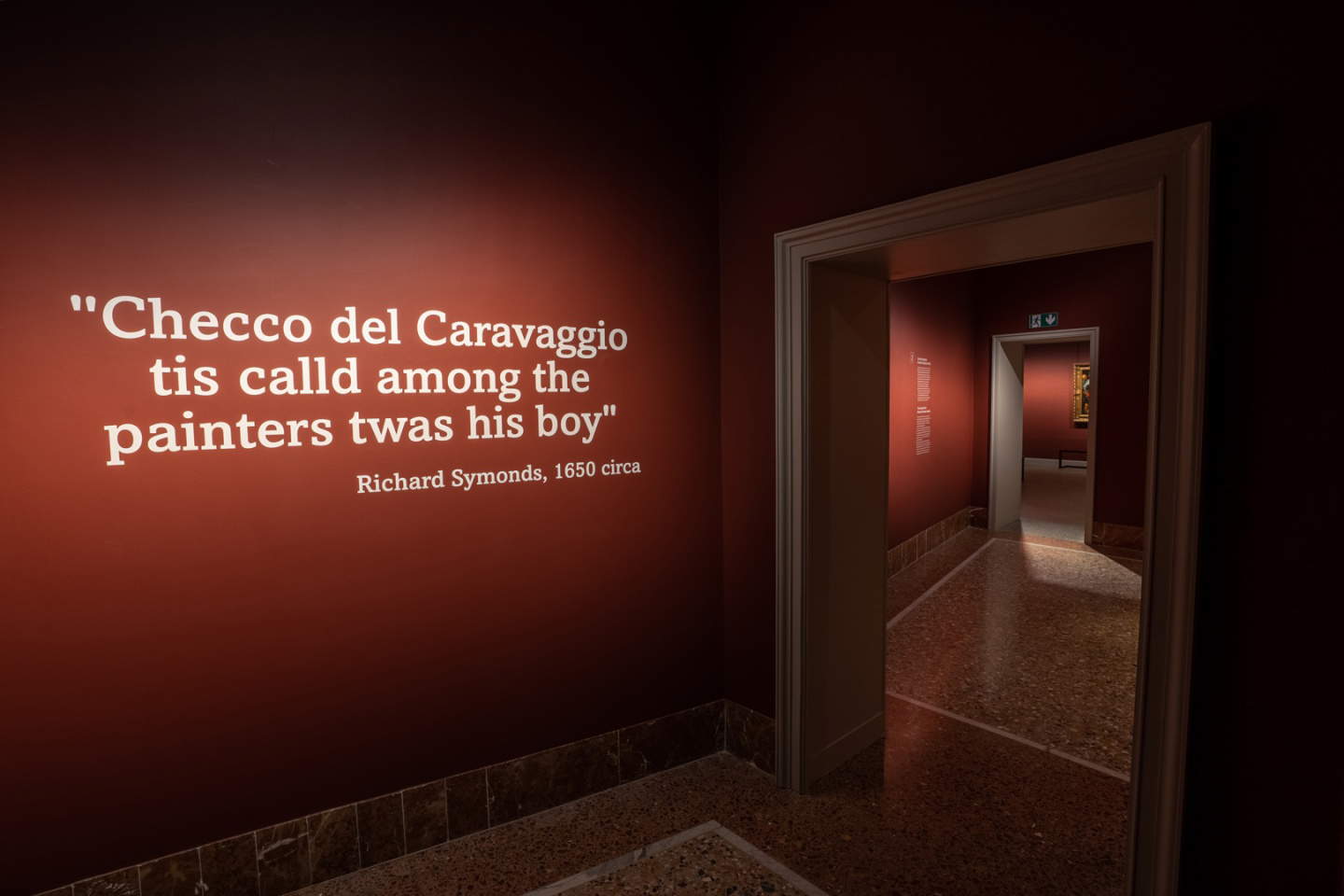



The nickname Cecco del Caravaggio is mentioned in a passage in Giulio Mancini’s Considerations on Painting , in which the medical biographer includes “Francesco detto Cecco del Caravaggio” in Caravaggio’s “schola” along with Ribera, Spadarino and Manfredi, that is, the four artists who carried on, each in his own way, the modes underlying Merisi’s naturalism . According to Papi, however, it was Michael Wiemers ’s 1986 article, in which a passage from the diary of Richard Symonds, an English traveler present in Rome around 1650, was made known, that gave the most likely and logical explanation for this nickname. The passage speaks of Caravaggio’sLove the Victor, then in the Giustiniani collection, revealing that the model who had posed for this work was indeed Cecco del Caravaggio: “it was his boy,” "his owne boy or servant thait laid with him," meaning the boy who lay with Caravaggio. Francesco was nicknamed Cecco del Caravaggio because his relationship with the master had been so close that it had etched into his identity, and moreover, the passage makes explicit that that bond was also sexual. Phrases, as Papi states, that confirmed Caravaggio’s homosexual inclinations and suggest that the kind of bond between Cecco and Caravaggio was known and passed down in Rome.
If the nickname alluded to artistic descent from Caravaggio, it could also allude to the widely known history between the two, interpreting the phrase in Symonds’ passage “Checco del Caravaggio tis calld among the painters” as “Checco del Caravaggio was known among the painters,” but also “among the painters he was called Checco del Caravaggio,” with derogatory and defamatory value. If this hypothesis were well-founded, “it could be advanced that Cecco may have been in a situation of separateness, if not even marginalization,” Papi writes in his essay. “But he himself could have, voluntarily, isolated himself and perhaps sought to frequent circles (and from these to have commissions) capable of appreciating him, of recognizing his qualities and of considering him as a fellow to whom (and only to him) to assign the execution of images of strongly ambiguous meaning, very different from those that other fellow painters could conceive. As if Cecco placed himself beyond (even humanly, even existentially) and consequently could produce works free of censorious fears, perhaps because they circulated in conscious circles. It is precisely these new reflections on Cecco, prompted by the exhibition, that make me conclude that Boneri must have frequented an inner circle of patrons (perhaps a sort of protective circle), in which it is still difficult to identify the protagonists (Montalto, as it turned out, may have been one of them).”
In 1992, on the occasion of the conference that took place at the conclusion of the major exhibition in Florence on Caravaggio curated by Mina Gregori, Gianni Papi expounded his thoughts on the similarities he traced in other works by Merisi with the model of theAmore vincitore, then identified the same features in the St. John the Baptist in the Pinacoteca Capitolina, the angel of the Conversion of St. Paul in the Odescalchi collection, the Isaac of the Sacrifice of Isaac now in the Uffizi, the David of the David with the Head of Goliath in the Borghese Gallery, the David of the David with the Head of Goliath in the Kunsthistorisches Museum in Vienna, and probably also the screaming altar boy of the Martyrdom of St. Matthew in St. Louis of the French. It is precisely this assumption that kicks off the exhibition at the Carrara Academy in Bergamo, the first exhibition dedicated in Italy and in the world to Cecco del Caravaggio. Visitors immediately come into contact with Caravaggio: on display before March 28 was the Saint John the Baptist from the Pinacoteca Capitolina, in which the saint is depicted as a fifteen- or sixteen-year-old teenager, naked, with a winking gaze as he mischievously embraces the head of a ram. The work, which returned to Rome while the exhibition was in progress, was later replaced by the Galleria Borghese’s David with the Head of Goliath, a work steeped in pathos where, as Jacomo Manilli wrote in 1650 to describe the canvas, “the David with the Head of Goliath is by Caravaggio; who in that head wished to portray himself; and in the David he portrayed his Caravaggino,” the latter with features now in his twenties and with a sorrowful, sad expression. According to Papi, Cecco may “have followed Merisi immediately to Zagarolo, where the Borghese canvas finds perhaps the most plausible place of execution; but it is also possible that the work was painted at the beginning of the Neapolitan sojourn, in the first months of his stay, between 1606 and 1607,” because of the tragic and desperate atmosphere of the image that reflects the dramatic period in Caravaggio’s life.
Caravaggio’s two paintings are followed by Giovanni Baglione ’s Amorsacro e Amor profano , which Herwarth Röttgen interpreted in 1992 as an “unequivocal though veiled accusation of sodomy by Baglione against Caravaggio,” identifying in the demon’s face the features of Caravaggio and in the half-naked boy on the ground a young lover of his. Interpretation that could be linked to what Papi saw in Caravaggio’s nickname Cecco, that is, to the story known in Roman circles between Caravaggio and Cecco. Next on display is the Portrait of a Young Man with Lettuce Collar, a work housed in the Uffizi that has been attributed to Cecco del Caravaggio because of the recognizable language in the execution and structure of the ruff that finds comparisons with elements of his other works, such as the shirt of the Flautist in theAshmolean Museum in Oxford, the smock of the angel in the Resurrection or in the collar of the Musical Instrument Maker in the Wellington Collection in London; it is a masculine image very similar to those to which Cecco accustomed us: according to Papi, his likeness is in fact recognized in it, thus arguing that the portrait is actually his self-portrait. This image was taken up by Bartolomeo Manfredi in the Portrait of Two Friends exhibited here, from a private collection, in which the male figure reappears with an almost identical face and pose, while the figure on the left would probably, according to Papi, be Manfredi’s self-portrait. The clear separation between the two figures would suggest, however, that they did not pose at the same time, thus opening questions about whether or not Cecco was in Rome at the time the painting was made. Manfredi was included by Giulio Mancini in Caravaggio’s aforementioned “schola”: the apprenticeship in Caravaggio’s studio must have been very different from that of the Florentine or Roman workshops, as the students learned to paint by observing the master and sharing life and artistic experiences with him.
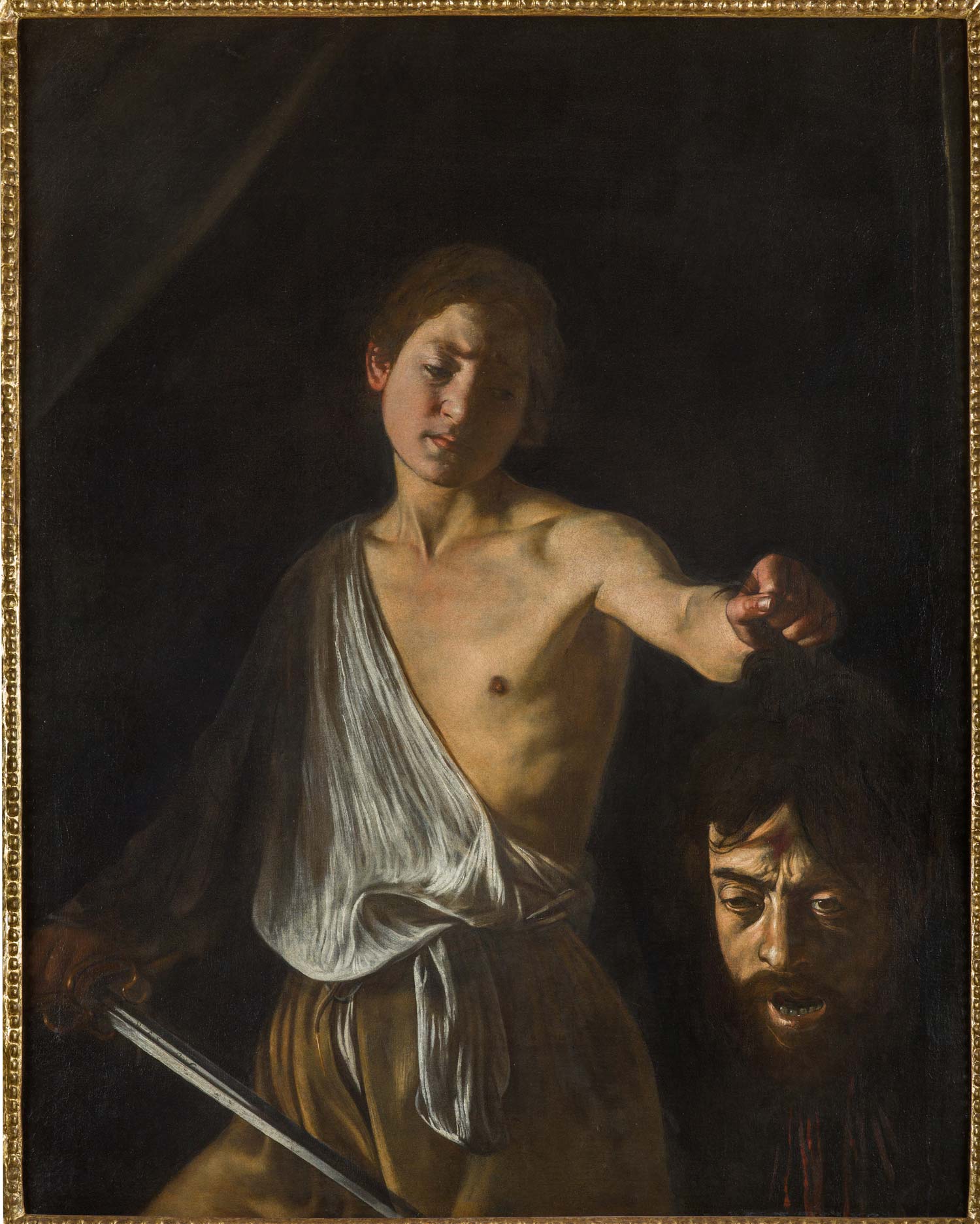
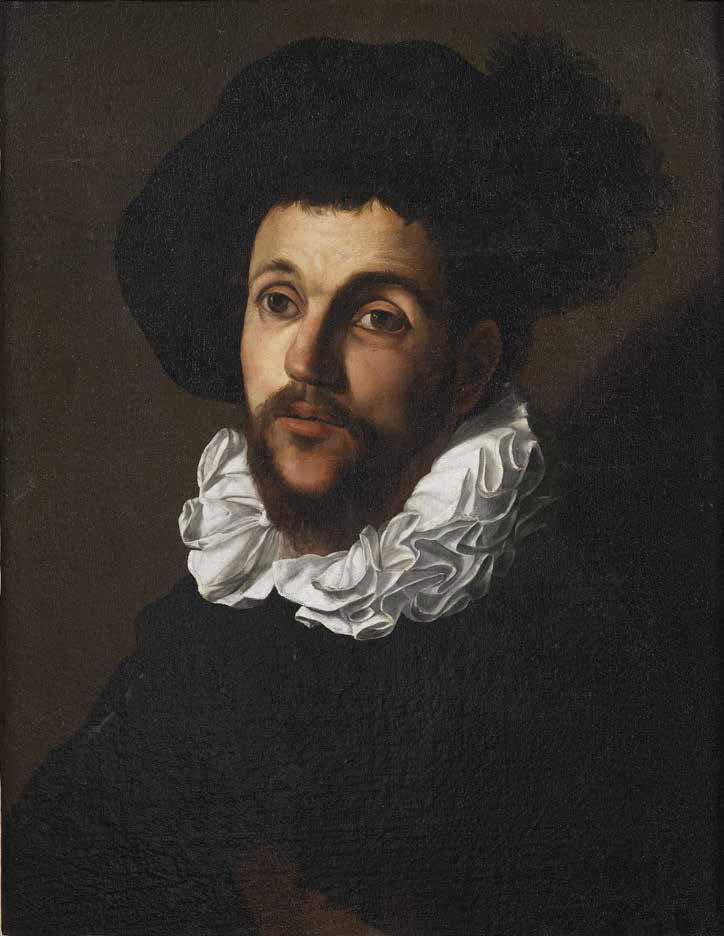
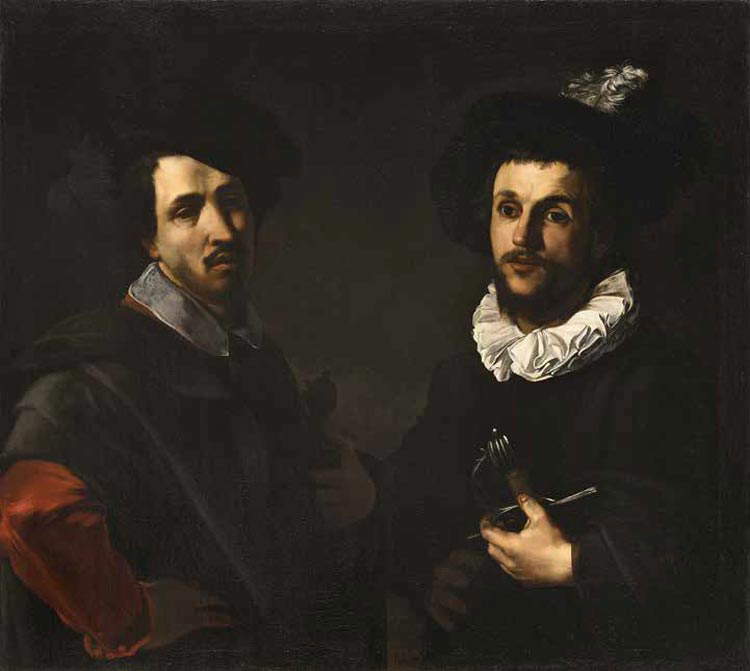
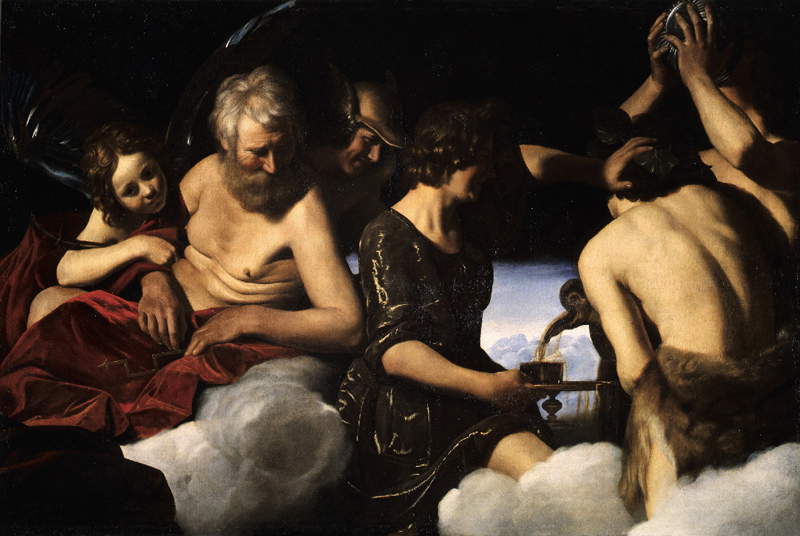

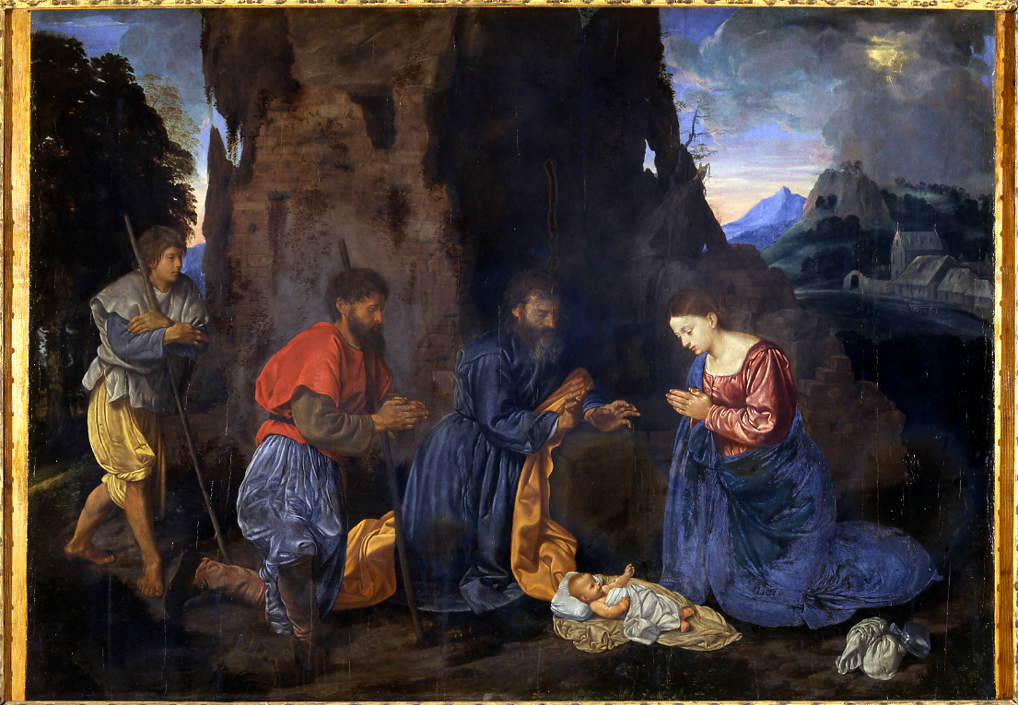
Also among Caravaggio’s close pupils was Spadarino, featured in the exhibition with the Uffizi’s Convito degli dei . Spadarino was also among the three painters Piero Guicciardini, Medici ambassador to Rome, had commissioned in 1619 to make an altarpiece each to decorate the family chapel in Santa Felicita in Florence: of these, only the one by Gerrit van Honthorst was known, namely theAdoration of the Shepherds that was badly damaged in the 1993 Georgofili massacre, but from documents that emerged a few years after the publication of Wiemers’ article about payments to the makers of the altarpieces, it was discovered that the other two were made-one by Spadarino and the other by a Francesco Boneri whom Papi in 1991 revealed to be Cecco del Caravaggio thanks to the entry as “Francesco del Caravaggio” in one of the documents. The scholar also discovered on the same occasion that the altarpiece made by the artist was the Resurrection (not in the exhibition) now in theArt Institute of Chicago, which Longhi first attributed in 1943 to Cecco. The work never reached Florence, however, as Guicciardini was bewildered by theunconventionality of the altarpiece; he got rid of it by selling it quickly, perhaps right away to Scipione Borghese since a few years later it was in his collection. From May 30, 1620, that is, the date of the final settlement for the Resurrection, there is no more direct news about Cecco, and only speculation can be made about his life and artistic path after the failure of the commission.
The next section presents masterpieces by Giovanni Gerolamo Savoldo such as the Adoration of theShepherds from the Galleria Sabauda in Turin and theAdoration of the Shepherds from the Pinacoteca Tosio Martinengo because Papi writes, “In fact, the relations of Cecco’s painting with Savoldo have always seemed to me very strong, so much so that the painting of the Brescian will have to be indicated as one of the fundamental matrices of Boneri’s language, of no less weight than the influence exerted by Merisi. I believe that the recurrence of stylistic solutions close to Savoldo is due not so much to the mediation of Caravaggio (who does not, for example, take on the more Nordicizing passages of the Brescian, while this aspect clearly affects Boneri), but to direct knowledge of works by the artist from Brescia.” Savoldo’s exhibited masterpieces testify to his strong influence on Cecco, “with the precision of the details, the lumescence of the fabrics, the turning of the hands, the limbs, the reddish color of the skin, and with that costuming of the first decades of the 16th century, rich and seductive,” the scholar explains. Cecco’s language, which takes the form of a daring naturalism but with roots firmly planted in the mid-sixteenth century, is the result of the intertwining of two experiences: that on Savoldo’s paintings, which makes his painting appear “in many ways neo-sixteenth-century both in terms of the fashion options and the crystalline hyperrealism of the forms and colors,” Papi explains, and his direct experience with Caravaggio, to whom he owes the bold iconographic innovations. The result is, in Papi’s words, “a painting that is harsh and sharp, audacious and ruthless, naked and raw, sensual and ancient, which finds its foundations in Lombardy.” Difficult to define, however, the times and places of contact with Savoldo’s works: he may have seen them before his meeting with Caravaggio, although perhaps Cecco was really too young, or he may have returned for a time to Lombardy and Venice after leaving Caravaggio in Zagarolo or Naples, thus between 1606-1607 and 1611-1612, before the painter’s reappearance in the Roman sphere, when in 1613-1614 he participated in the decoration of the Montalto casino of Villa Lante in Bagnaia in the group of artists working with Agostino Tassi. The latter in fact recalls in 1619, on the occasion of one of his trials, the presence of “Ceccho del Caravaggio” in that undertaking six years earlier. From that testimony we know that Cecco slept in the same room as Tassi and is the only one mentioned by his nickname compared to the other collaborators, so presumably he had a leading role in the commission on that occasion.
The following chapters of the exhibition count as many as nineteen works by Cecco del Caravaggio-a historic event, considering that there are about twenty-five known paintings by the artist, made possible by national and international loans from museums in Berlin, London, Madrid, Oxford, Warsaw, Vienna, Brescia, Florence, Milan, and Rome, with the aim of providing the visitor with the most complete and cross-cutting look possible at the painter’s output through those masterpieces that have proved to be fundamental to the reconstruction of Cecco’s body of work. These include the Tribute of the Coin now housed at the Kunsthistorisches Museum in Vienna recently added to Cecco’s catalog thanks to Gerlinde Gruber and which Papi says could hint at a Neapolitan setting (the scholar is convinced of a Neapolitan sojourn by Boneri). Also a recent addition to the catalog thanks to Gianni Papi’s contribution is the Erythraean Sibyl from the Pizzi collection in Venice: in it the scholar has found Cecco’s unmistakable stylistic features, such as the hands placed one on top of the other with the typical large, volumetric fingers, the red cloak with golden silk lapels, and the shredded sleeves in a fashion that finds comparisons to examples in the two Athens and London versions of The Manufacturer of Musical Instruments. The Bratislava’sAndata al Calvario sees in thearmiger depicted from behind on the far left in tight-fitting stockings an identical reference to the fresco depicting Alexander the Great greeting defeated Darius in the Montalto Casino in the Villa Lante at Bagnaia, and which in turn was recovered by Pedro Núñez in the Dublin’s Jael and Sisara .
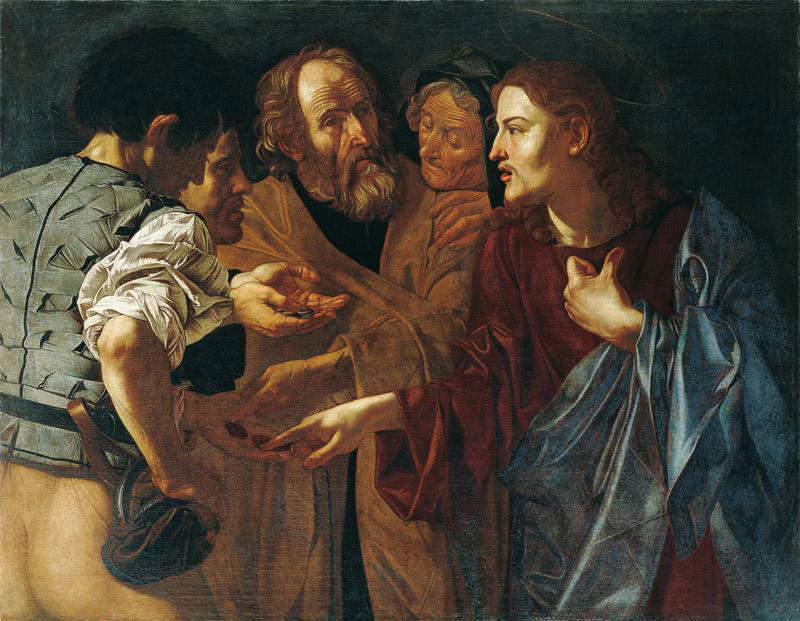

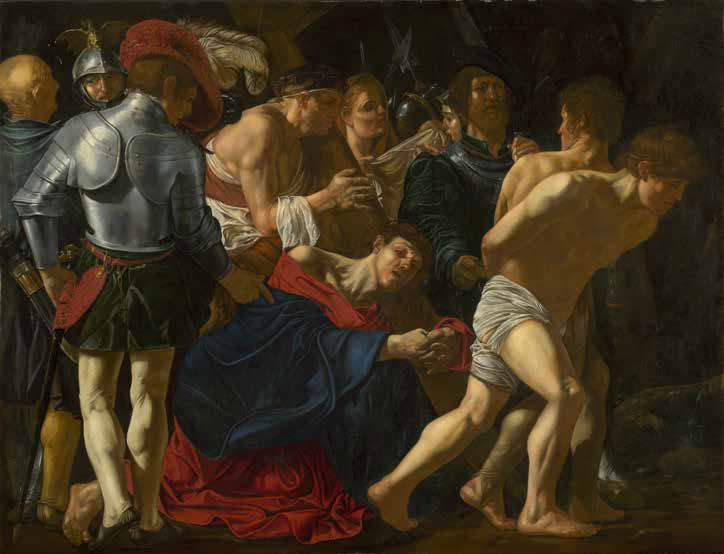 Francesco Boneri known as Cecco
Francesco Boneri known as Cecco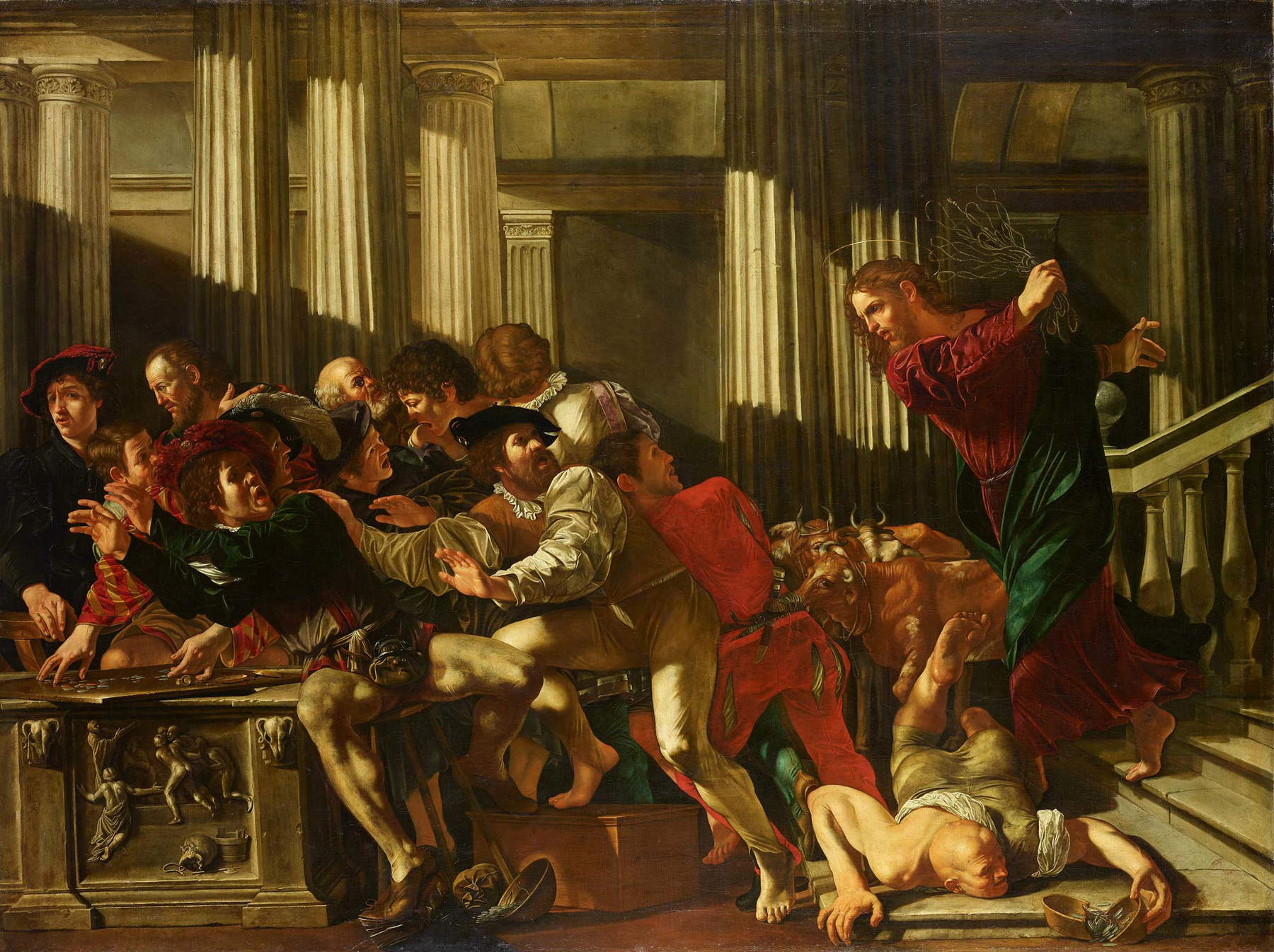

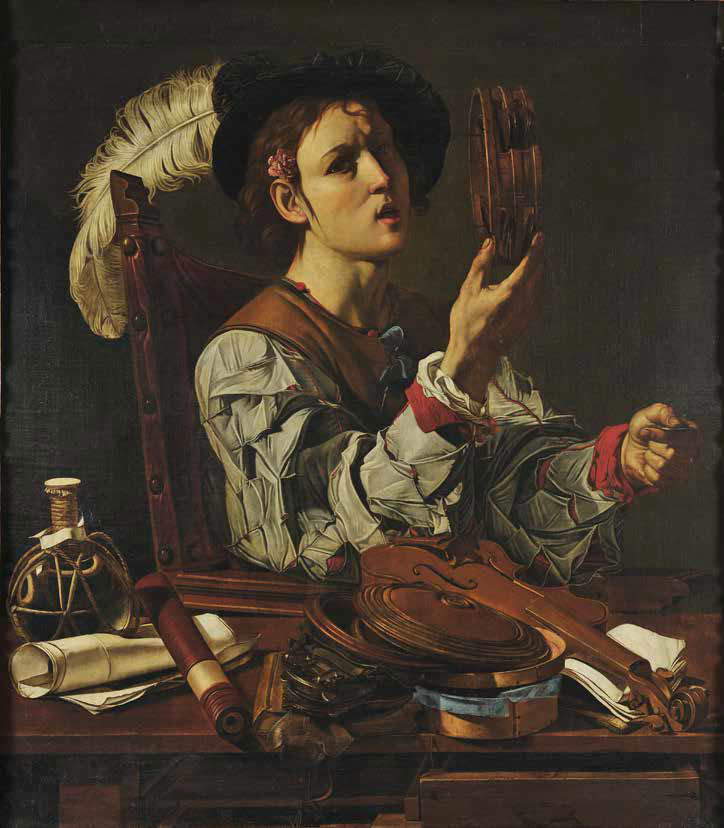
 Francesco Boneri known as
Francesco Boneri known as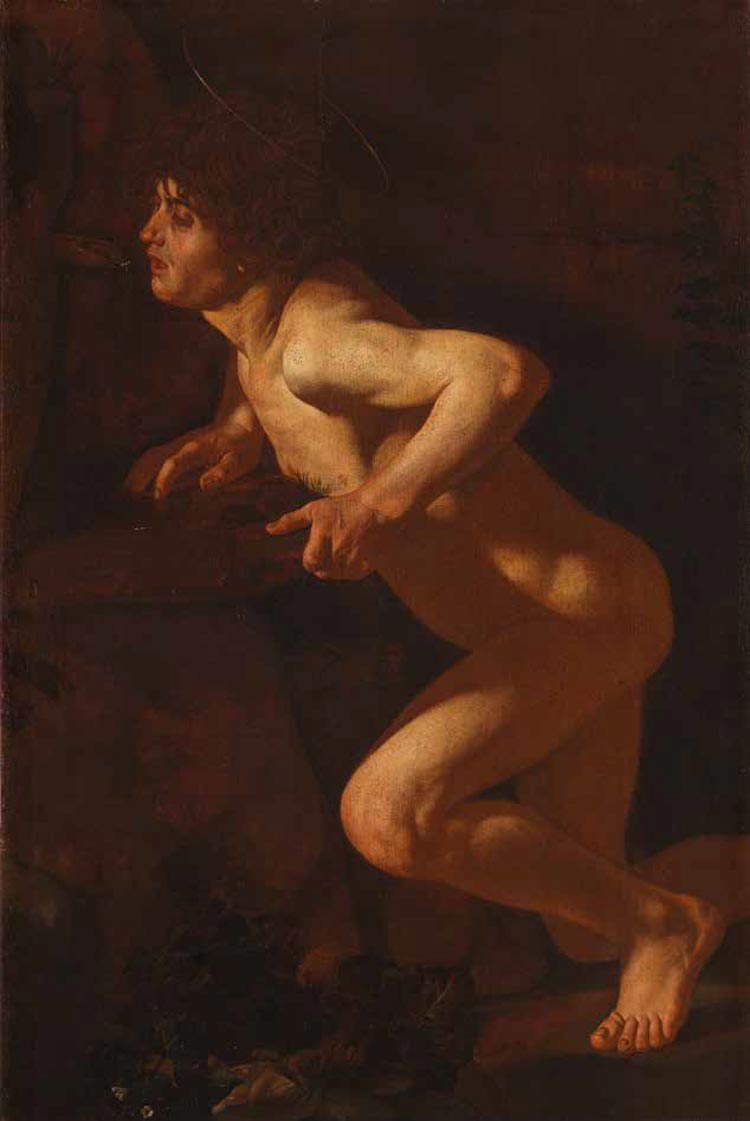
 Francesco Boneri known as Cecco
Francesco Boneri known as Cecco

Fundamental to the reconstruction of Cecco’s corpus is the Expulsion of the Merchants from the Temple in Berlin: through the sonnet dedicated to the work by Silos in his Pinacotheca where the painting, then in the Giustiniani collection in Rome, turns out to be by “Checchi à Caravagio,” Longhi in 1943 linked to the painting a quotation from the painter traceable in Giulio Mancini’s Considerations . Thus recognizing the author in Cecco del Caravaggio, he could also attribute other paintings to the artist, such asLove at the Fountain in a private collection, Resurrection in the Art Institute of Chicago, and The Flautist in the Ashmolean Museum, Oxford. In addition to the fury of Christ terrorizing the merchants, note in the Expulsion the rendering of the materials of the objects and the luministic effects that define them, but also the pure colors, drapery, gestures influenced by Savoldo. And furthermore, Papi recognizes in the figure of the young man on the far left in the red hat, dressed almost as a dandy, a self-portrait of Cecco , and the defiladed position and almost disgusted facial expression suggest that the character is part of the scene but detached from it. Another masterpiece in the exhibition is the Saint Lawrence, depicted with an unusual iconography: dressed in an archdeacon’s robe of deep purple red, the saint is in a meditative pose, looking up to the sky and his hands crossed near his face, surrounded by splendid still-life pieces that stylistically bring the painting closer to the two versions of the Musical Instrument Maker. On the balustrade are a volume, some documents, from which hangs a leaden seal with the inscription “DAM/ASO PA/ PA PRI/MO,” and a circular metal shrine with a lumpy substance inside. In her essay, Francesca Curti explains how Cecco had entrusted the key to interpreting the painting precisely to the objects placed on the balustrade: the parchment, the red wax seal of a papal bull, the hanging leaden seal of Damasus I, and the volume, perhaps a formulary, are all elements that refer to the Apostolic Chancery. If one takes into account that the Chancery building houses the church of St. Lawrence in Damasus, one can assume that the saint depicts not only himself but also the Dalmatian church and that the documents and volume are allegorical representations of the Chancery building. Finally, if we take into account that at the time of the painting’s completion the office of vice-chancellor of the Chancery, to whom the title of St. Lawrence in Damasus also belonged by right, was Cardinal Alessandro Peretti Montalto for whom Cecco had just finished the fresco in Bagnaia, then we can think that the possible commissioner of the painting was the latter. In fact, Montalto recognized himself as a continuer of the saint’s work, having wanted to imprint his pastoral mission in assisting the needy.
The exhibition then confronts the visitor with two extraordinary comparisons: the one between the two aforementioned Athens and London versions of The Musical Instrument Maker, which see almost identical the still life on the table, while noting differences in the character, such as the lack in the Athens version of the lettuce collar, the attitude to singing in the Athens painting and the difference in the material of the hat (velvet in the Athens one and faux fur with velvet decorations the London one), and the comparison between St. John the Baptist at the Fountain from the Pizzi Collection andLove at the Fountain from the Koelliker Collection (most likely a fragment of a second redaction of theLove at the Fountain that we know in its entirety through the private collection canvas, which is not on loan). However, even the Koelliker canvas denotes a sensual and provocative pose of the boy leaning toward the fountain to quench his thirst, with a strong homosexual connotation.
Also present in the room is the Flutist from the Ashmolean Museum, Oxford, which has always impressed with the spectacular still life piece on the table and shelves. "The naturalistic exasperation circulating in Cecco’s works (to the point that we might speak in some cases of hyperrealism ante litteram) suggests that he too, like his master, may have executed autonomous still lifes,“ Papi writes in his catalog essay. ”At the moment we do not know of any for sure, but they make this circumstance more consistent the extraordinary pieces of fruit, of musical instruments, of objects defined down to the smallest detail," scattered in paintings such as Flautist, St. Lawrence and Musical Instrument Maker.
Finally, Man with Rabbit and Girl with Dove, now preserved in Madrid, both come from the collection of Elisabetta Farnese, as indicated by the small fleur-de-lis in the lower right margin. The two paintings have been seen as pendants, but there is no certainty, and some scholars disagree with this hypothesis; however, they are evidence of the artist’s extraordinary painterly and even enigmatic skills.


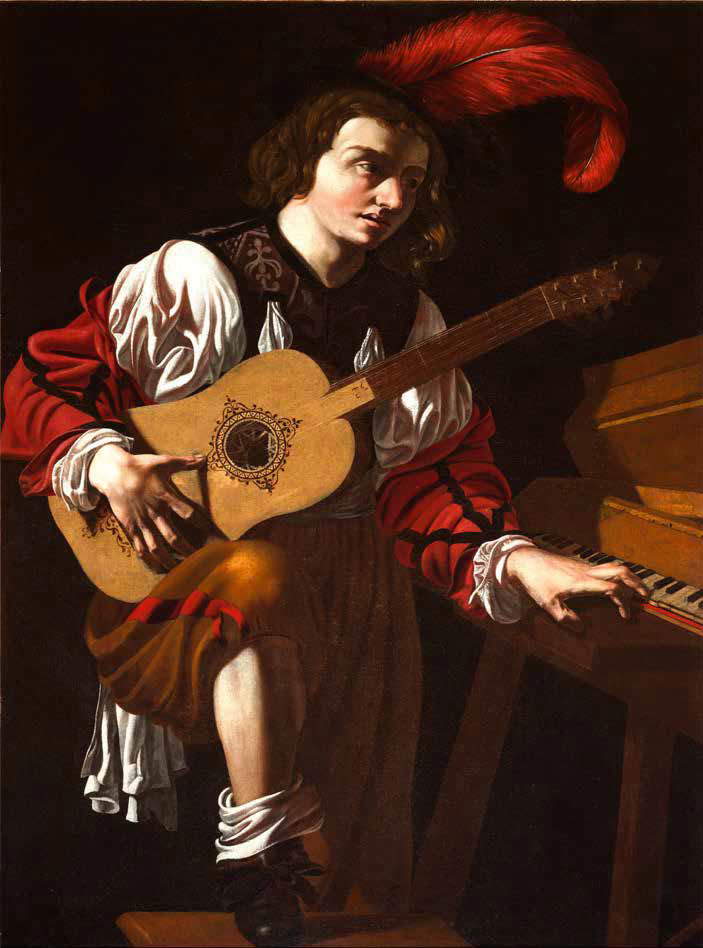
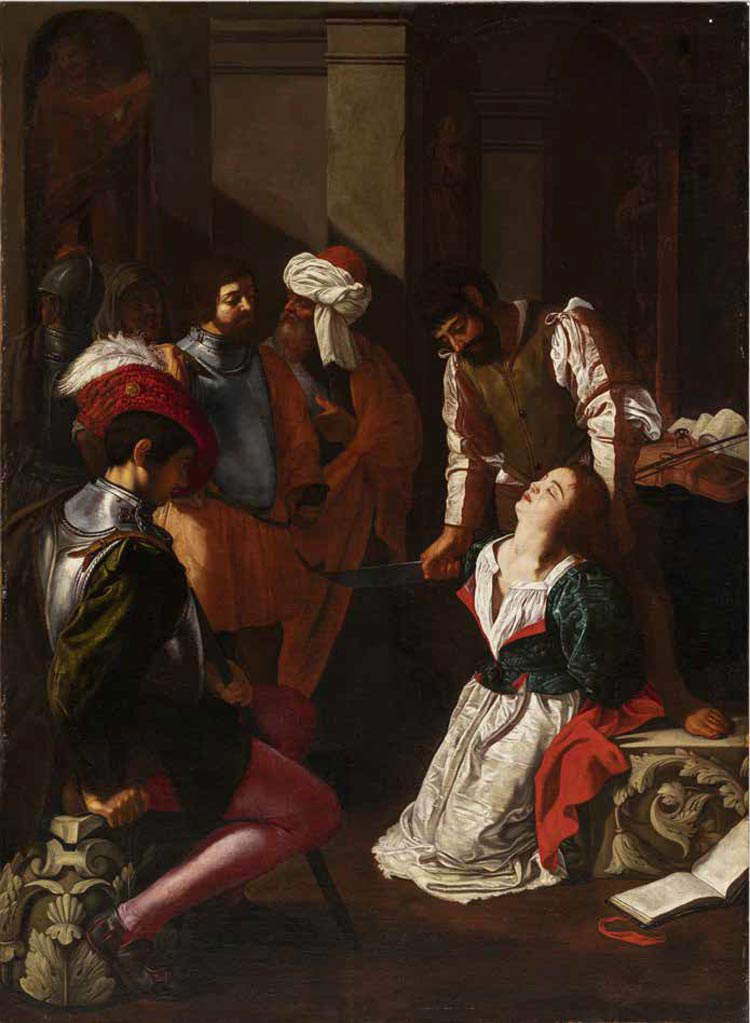
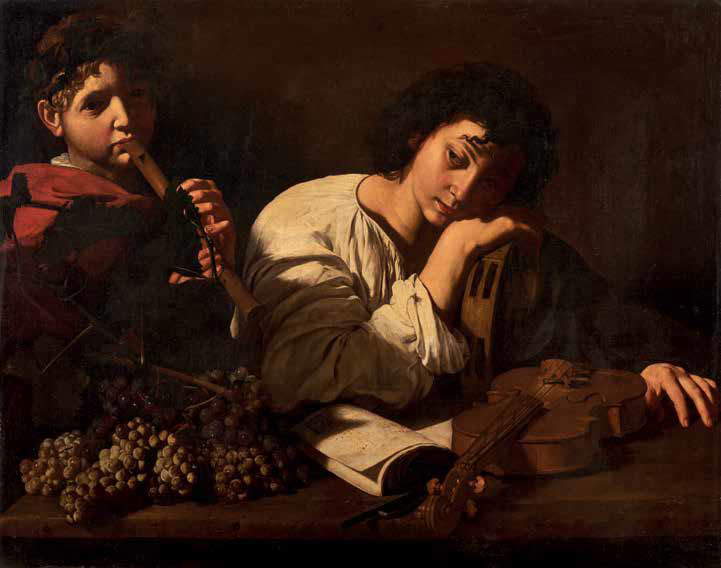

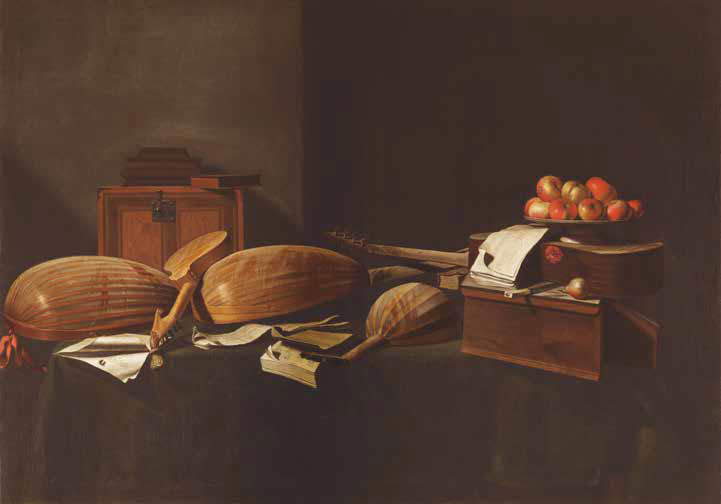
The exhibition continues with the curators’ desire to illustrate comprehensively and with important works the relationships that many artists had with Cecco: in addition to the Neapolitan testimonies that hint at the painter’s presence in the Neapolitan city (Filippo Vitale and Louis Finson), Boneri’s influence in the Roman sphere is broader, starting with Valentin de Boulogne (several of his works are exhibited here, of which the Death of Hyacinthus is notable), but also in Gérard Douffet, shown here with theArmiger of the Uffizi, in Juan Bautista Maino with the St. Matthew and the Angel, in the Monogrammist RG here with the Suonatore che accorda la chitarra and with theIncoronazione di spine, in Pedro Núñez del Valle ( Martyrdom of St. Cecilia exhibited here) who so assimilated Boneri’s style that in the past some of the Spaniard’s works were mistaken as Cecco’s autographs. Also important was his relationship with Bartolomeo Cavarozzi (probably the earliest redaction of Aminta’s Lamento is exhibited here) and with Antiveduto Gramatica for his depiction of still lifes with musical instruments. In fact, among the most interesting works in the penultimate room is Gramatica’s Concerto, which refers to those concert scenes that were held in the palaces of Cardinal Del Monte and Cardinal Montalto, the latter being fundamental in the affairs of Caravaggio and Cecco.
The exhibition ends with an exemplary painting by Evaristo Baschenis, the Still Life of the Agliardi Triptych. Gianni Papi has repeatedly considered since 1992 the possibility that Baschenis may have seen some of Caravaggio’s Cecco’s still life works, perhaps in Bergamo or even Rome, and thus drawn inspiration to make still lifes with musical instruments. Real compositions of musical instruments, such as the one in the exhibition, which Longhi defined as “miscellany of objects at the finish line of immobility” on which Baschenis “first sprinkles, then finger-removes (for greater ’deception’) the dust on the backs, and from the backs, of the famous Cremonese lutes.”
Caravaggio’s Cecco. The Model Pupil accompanies the visitor in discovering, as far as reconstructions on his life and production are still in progress, an out-of-the-box painter, sometimes ambiguous in his erotic references, capable of great virtuosity but also of iconographic novelty. An artist who is presented through a well-reasoned exhibition itinerary that starts with his two “masters,” namely Caravaggio and Savoldo, ending with the influences of his art on other painters. And in between is the extraordinary opportunity to admire the majority of his masterpieces reunited. It is an exhibition that is the result of more than 30 years of research, but has also been able to count on recent updates. A fine opportunity to be able to be in front of an artist who is too little known to the public and whom this exhibition has the merit of making known for the first time in these terms, albeit still with the limitations of the case. Also remarkable is the catalog that accompanies the exhibition, complete with essays, worksheets, biographical hypotheses and documentary traces, which puts in writing everything there is to say so far about the research and studies about Caravaggio’s closest pupil and model.
Warning: the translation into English of the original Italian article was created using automatic tools. We undertake to review all articles, but we do not guarantee the total absence of inaccuracies in the translation due to the program. You can find the original by clicking on the ITA button. If you find any mistake,please contact us.